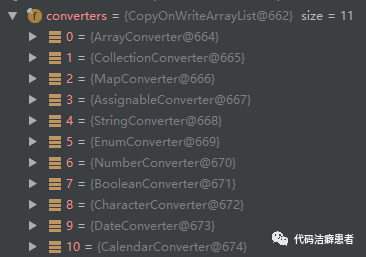使用 ModelMapper 的一次踩坑经历

警告:本文代码较多,请耐心观看
在实际项目中,我们常常需要把两个相似的对象相互转换,其目的是在对外提供数据时需要将一部分敏感数据(例如:密码、加密token等)隐藏起来。最普通的方法是,新建一个对象,将需要的值逐个set进去。如果有多组需要这样转换的对象,那么就需要做很多只是get/set这样无意义的工作。
在这样的背景下,ModelMapper诞生了,它是一个 简单 、 高效 、智能的对象映射工具。它的使用非常简单,首先添加maven依赖
<dependency> <groupId>org.modelmapper</groupId> <artifactId>modelmapper</artifactId> <version>2.1.1</version> </dependency>
然后就可以直接new出一个ModelMapper对象,并且调用其map方法将指定对象的值映射到另一个对象上了。
使用方法今天不做过多介绍,大家可以自行Google,找到ModelMapper的相关文档进行学习。今天要分享的时前几天无意间踩到的一个坑。
我有两个类,PostDO和PostVO(这里只截取了部分字段,因此两个类的含义也不做解释了):
public class PostDO {
private Long id;
private String commentId;
private Long postId;
private int likeNum;
}
public class PostVO {
private Long id;
private boolean like;
private int likeNum;
}
在一个方法中,我试图将PostDO的一个对象映射到PostVO,因此我进行如下操作:
public class Application {
public static void main(String[] args) {
ModelMapper modelMapper = new ModelMapper();
PostDO postDO = PostDO.builder().id(3L).likeNum(0).build();
PostVO postVO = modelMapper.map(postDO, PostVO.class);
System.out.println(postVO);
}
}
执行结果是这样的:
PostVO(id=3, like=false, likeNum=0)
无异常,项目中likeNum字段的值是随着项目的进行递增的。当 likeNum增加到2 时,异常出现了:
Exception in thread "main" org.modelmapper.MappingException: ModelMapper mapping errors: 1) Converter org.modelmapper.internal.converter.BooleanConverter@497470ed failed to convert int to boolean. 1 error at org.modelmapper.internal.Errors.throwMappingExceptionIfErrorsExist(Errors.java:380) at org.modelmapper.internal.MappingEngineImpl.map(MappingEngineImpl.java:79) at org.modelmapper.ModelMapper.mapInternal(ModelMapper.java:554) at org.modelmapper.ModelMapper.map(ModelMapper.java:387) at Application.main(Application.java:7) Caused by: org.modelmapper.MappingException: ModelMapper mapping errors: 1) Error mapping 2 to boolean 1 error at org.modelmapper.internal.Errors.toMappingException(Errors.java:258) at org.modelmapper.internal.converter.BooleanConverter.convert(BooleanConverter.java:49) at org.modelmapper.internal.converter.BooleanConverter.convert(BooleanConverter.java:27) at org.modelmapper.internal.MappingEngineImpl.convert(MappingEngineImpl.java:298) at org.modelmapper.internal.MappingEngineImpl.map(MappingEngineImpl.java:108) at org.modelmapper.internal.MappingEngineImpl.setDestinationValue(MappingEngineImpl.java:238) at org.modelmapper.internal.MappingEngineImpl.propertyMap(MappingEngineImpl.java:184) at org.modelmapper.internal.MappingEngineImpl.typeMap(MappingEngineImpl.java:148) at org.modelmapper.internal.MappingEngineImpl.map(MappingEngineImpl.java:113) at org.modelmapper.internal.MappingEngineImpl.map(MappingEngineImpl.java:70) ... 3 more
提示int类型不能转换成boolean型,很明显。ModelMapper是将like字段映射到likeNum了。那么ModelMapper究竟是怎样进行映射的呢,我们一起来看一下ModelMapper的源码。
ModelMapper利用反射机制,获取到目标类的字段,并生成期望匹配的 键值对 ,类似于这样。

接着对这些键值对进行遍历,逐个寻找源类中可以匹配的字段。首先会根据目标字段判断是否存在对应的映射,
Mapping existingMapping = this.typeMap.mappingFor(destPath);
if (existingMapping == null) {
this.matchSource(this.sourceTypeInfo, mutator);
this.propertyNameInfo.clearSource();
this.sourceTypes.clear();
}
如果不存在,就调用matchSource方法,在源类中根据匹配规则寻找可以匹配的字段。匹配过程中,首先会判断目标字段的类型是否在类型列表中存在,如果存在,则可以根据名称,加入匹配的mappings中;如果不存在,则需要判断converterStore中是否存在能够应用于该字段的转换器。
if (this.destinationTypes.contains(destinationMutator.getType())) {
this.mappings.add(new PropertyMappingImpl(this.propertyNameInfo.getSourceProperties(), this.propertyNameInfo.getDestinationProperties(), true));
} else {
TypeMap<?, ?> propertyTypeMap = this.typeMapStore.get(accessor.getType(), destinationMutator.getType(), (String)null);
PropertyMappingImpl mapping = null;
if (propertyTypeMap != null) {
Converter<?, ?> propertyConverter = propertyTypeMap.getConverter();
if (propertyConverter == null) {
this.mergeMappings(propertyTypeMap);
} else {
this.mappings.add(new PropertyMappingImpl(this.propertyNameInfo.getSourceProperties(), this.propertyNameInfo.getDestinationProperties(), propertyTypeMap.getProvider(), propertyConverter));
}
doneMatching = this.matchingStrategy.isExact();
} else {
Iterator var9 = this.converterStore.getConverters().iterator();
while(var9.hasNext()) {
ConditionalConverter<?, ?> converter = (ConditionalConverter)var9.next();
MatchResult matchResult = converter.match(accessor.getType(), destinationMutator.getType());
if (!MatchResult.NONE.equals(matchResult)) {
mapping = new PropertyMappingImpl(this.propertyNameInfo.getSourceProperties(), this.propertyNameInfo.getDestinationProperties(), false);
if (MatchResult.FULL.equals(matchResult)) {
this.mappings.add(mapping);
doneMatching = this.matchingStrategy.isExact();
break;
}
if (!this.configuration.isFullTypeMatchingRequired()) {
this.partiallyMatchedMappings.add(mapping);
break;
}
}
}
}
if (mapping == null) {
this.intermediateMappings.put(accessor, new PropertyMappingImpl(this.propertyNameInfo.getSourceProperties(), this.propertyNameInfo.getDestinationProperties(), false));
}
}
默认的转换器有11中:

找到对应的converter后,converter的map方法返回一个 MatchResult ,MatchResult有三种结果:FULL、PARTIAL和NONE(即全部匹配, 部分匹配 和不匹配)。注意,这里有一个部分匹配,也就是我所踩到的坑,在对like进行匹配是,likeNum就被定义为部分匹配。因此,当likeNum大于2时,就不能被转换成boolean类型。
这里解决方法有两种,一种是在设置中,规定必须字段名完全匹配;另一种就是将 匹配策略 定义为严格。设置方法如下:
modelMapper.getConfiguration().setFullTypeMatchingRequired(true); modelMapper.getConfiguration().setMatchingStrategy(MatchingStrategies.STRICT);
到这里,ModelMapper会选出较为合适的源字段,但是如果匹配要求不高的话,ModelMapper可能会筛选出多个符合条件的字段,因此,还需要进一步过滤。
PropertyMappingImpl mapping;
if (this.mappings.size() == 1) {
mapping = (PropertyMappingImpl)this.mappings.get(0);
} else {
mapping = this.disambiguateMappings();
if (mapping == null && !this.configuration.isAmbiguityIgnored()) {
this.errors.ambiguousDestination(this.mappings);
}
}
这里我们看到,如果匹配到的结果只有1个,那么就返回这个结果;如果有多个,则会调用disambiguateMappings方法,去掉有歧义的结果。我们来看一下这个方法。
private PropertyMappingImpl disambiguateMappings() {
List<ImplicitMappingBuilder.WeightPropertyMappingImpl> weightMappings = new ArrayList(this.mappings.size());
Iterator var2 = this.mappings.iterator();
while(var2.hasNext()) {
PropertyMappingImpl mapping = (PropertyMappingImpl)var2.next();
ImplicitMappingBuilder.SourceTokensMatcher matcher = this.createSourceTokensMatcher(mapping);
ImplicitMappingBuilder.DestTokenIterator destTokenIterator = new ImplicitMappingBuilder.DestTokenIterator(mapping);
while(destTokenIterator.hasNext()) {
matcher.match(destTokenIterator.next());
}
double matchRatio = (double)matcher.matches() / ((double)matcher.total() + (double)destTokenIterator.total());
weightMappings.add(new ImplicitMappingBuilder.WeightPropertyMappingImpl(mapping, matchRatio));
}
Collections.sort(weightMappings);
if (((ImplicitMappingBuilder.WeightPropertyMappingImpl)weightMappings.get(0)).ratio == ((ImplicitMappingBuilder.WeightPropertyMappingImpl)weightMappings.get(1)).ratio) {
return null;
} else {
return ((ImplicitMappingBuilder.WeightPropertyMappingImpl)weightMappings.get(0)).mapping;
}
}
ModelMapper定义了一个权重,来判断源字段是否有歧义,这里根据 驼峰式 的规则(也可以设置为下划线),将源和目标字段名称进行拆分,根据 匹配数量/源token数+目标token数,得到一个匹配的比率,比率越大,说明匹配度越高。最终取得匹配 权重最大 的那个字段。其他字段被认为是有歧义的。
截至目前,默认的ModelMapper的map方法的工作原理已经介绍完了,中间可能有些遗漏的细节,或者哪里有说的不明白的地方,欢迎大家和我一起讨论。大家在用到ModelMapper时一定要注意字段名,如果有相近的字段名,必须认真核对匹配是否正确,必要时就采用严格匹配策略。
对ModelMapper的基础使用方法不熟悉的同学可以访问它的官网查看相关文档:
http://modelmapper.org/
最后,感谢 赞 和 转 发。












![[HBLOG]公众号](https://www.liuhaihua.cn/img/qrcode_gzh.jpg)

